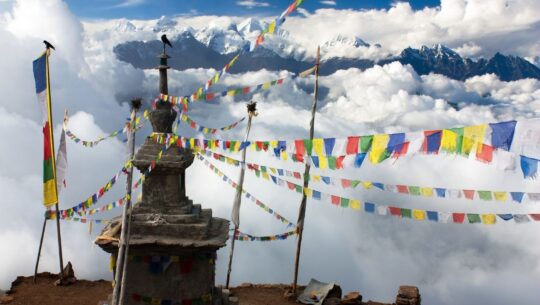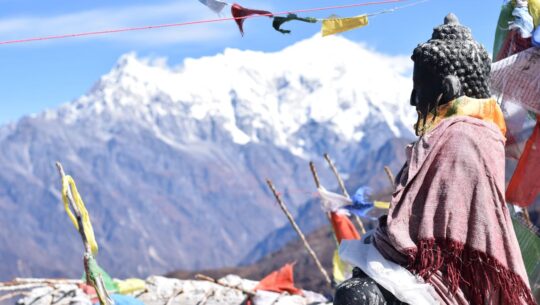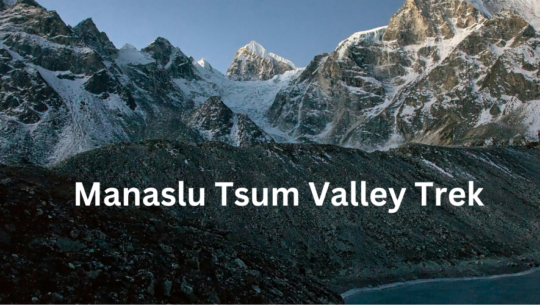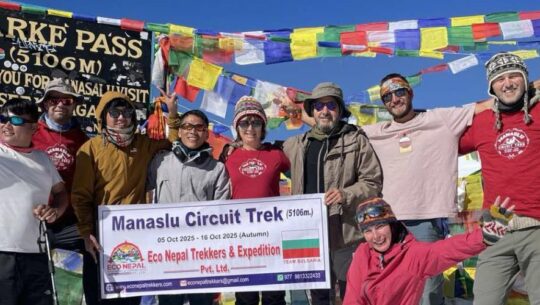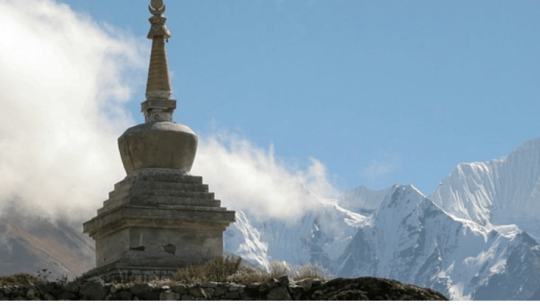Tamang Heritage Trail Trek | 12 Days Cultural Package
TripAdvisor Reviews Recommended by 99.99% travelers
USD 950
Nepal
12 Days
Moderate
4,984m at Tserko Ri
Homestay/Tea house/Guest house
Private vehicle/Bus
2-15
Feb, Mar, Apri, May, June, Sep, Oct, Nov & Dec.
- The Tamang Heritage Trail takes you through five authentic Tamang villages where Tibetan Buddhist culture remains vibrantly alive.
- Experience the Dawa Dangpo Tsechu Festival in Briddim village, featuring five days of traditional mask dances and Buddhist ceremonies.
- Stay with local Tamang families in traditional homestays and participate in their daily Buddhist rituals and cooking traditions.
- Trek through Langtang National Park and witness the community’s remarkable resilience after the 2015 earthquake devastation.
- Visit the 600-year-old Kyanjin Gompa monastery and join monks in their pre-dawn meditation and chanting sessions.
- Soak in natural hot springs at Tatopani village while learning about traditional healing practices passed through generations.
- Explore shamanic traditions in Thuman village and witness the unique Ghode Ghoma horse dance performances.
- Walk across the iconic Markhu suspension bridge spanning 100 meters above the valley with stunning mountain views.
- Climb Tserko Ri at 4,984m for breathtaking views of Langtang Lirung, Dorje Lakpa, and the entire Himalayan range.
- Learn traditional Tamang crafts, including weaving, wood carving, and Buddhist art creation, from local master craftsmen.
Tamang Heritage Trail Trek | 12 Days Cultural Package Brief Insight
Can you believe that a single trek can combine ancient Buddhist culture, authentic village homestays, and stunning Himalayan views?
We know it sounds too good to be true, but the Tamang Heritage Trail delivers exactly this experience in 12 days.
Just 117 kilometers north of Kathmandu lies a cultural treasure that most trekkers overlook while rushing to Everest or Annapurna. However, it might be because the Tamang Heritage Trail opened to tourists only in 2004 through the Tourism for Rural Poverty Alleviation Program.
This newly developed cultural circuit was specifically designed to preserve and showcase the authentic lifestyle of the Tamang people.
The name “Tamang” itself comes from Tibetan words: “Ta” meaning horse, and “Mang” meaning traders.
These ancient horse traders settled along the Tibet-Nepal border centuries ago and maintained their distinct cultural identity.
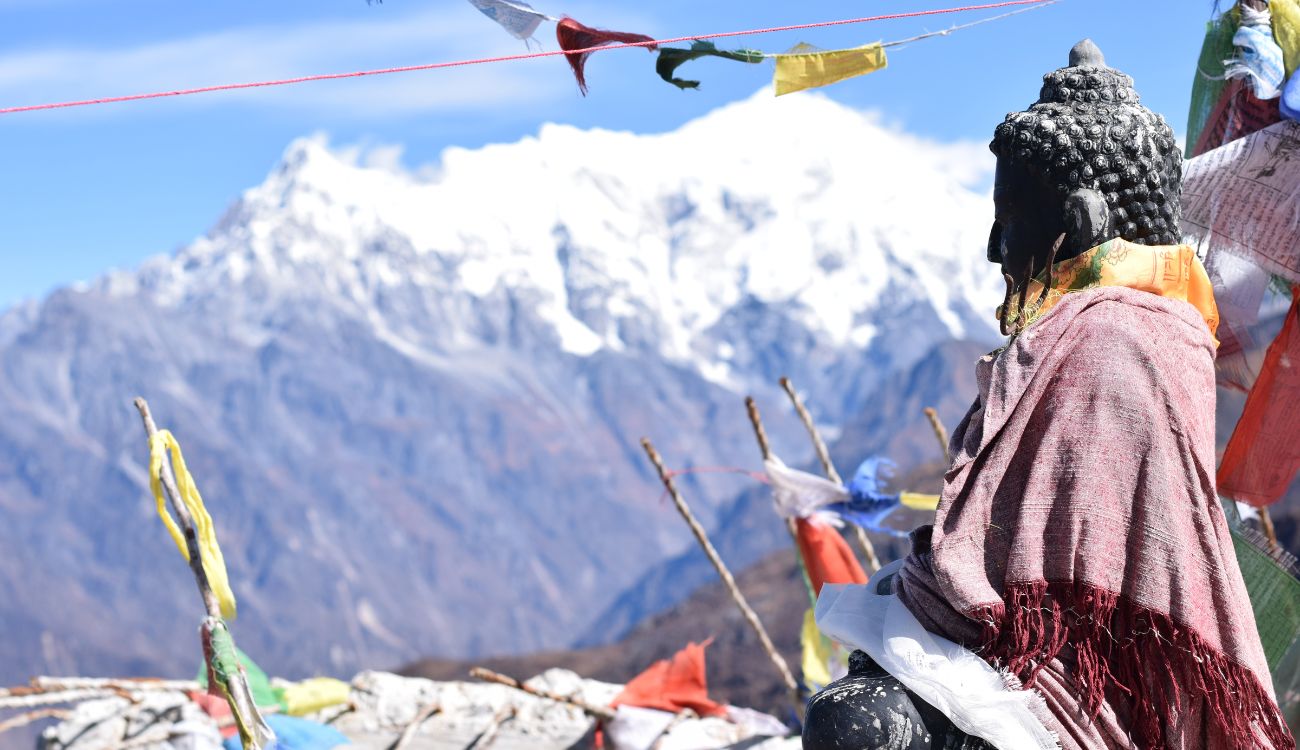
What makes this trek special is its focus on living culture rather than just mountain views. You won’t just visit villages. You will live with the Tamang families and participate in their daily Buddhist practices.
The trail connects five major Tamang villages: Gatlang, Tatopani, Thuman, Briddim, and sections of Langtang Village. Each village maintains distinct cultural practices, festival traditions, and craft specialties passed through countless generations.
Unlike the mainstream Langtang Valley Trek, this route prioritizes cultural engagement over peak conquests and altitude achievements.
But hey, similar to other Langtang journeys, the maximum elevation of this journey is also 4,984m at Tserko Ri. Now, you might be wondering if it’s just like any other cultural experience of Nepal. Well, it’s a little different.
The Dawa Dangpo Tsechu Festival in Briddim village transforms this quiet settlement into a living cultural museum.
In fact, this five-day Buddhist celebration happens annually in late February to early March, ten days after Gyalbo Lhosar. During this period, over 15 traditional dances unfold around raised altars while the entire village participates in ceremonies.
Besides the main festival, you can also time your trek with Janaipurnima at Parvati Kund in August. This sacred festival brings hundreds of Hindu and Buddhist pilgrims to Gatlang for ritual bathing and blessing ceremonies.
As a matter of fact, the unique dual-religious celebration demonstrates the Hindu-Buddhist characteristic of Tamang culture throughout the region.
Furthermore, the Tarna Festival in Upper Langtang celebrates Guru Rinpoche’s 600-year meditation in sacred caves.
This August-September celebration features monastery ceremonies and pilgrimages that connect ancient spiritual traditions with modern practice.
The homestay network throughout the trail allows genuine cultural exchange rather than superficial tourist observations. You will sleep in traditional Tamang homes, share meals around central hearths, and learn family stories.
Traditional craft instruction includes weaving on authentic hand looms, wood carving techniques, and Buddhist art creation. Daily Buddhist practice participation lets you join morning prayers, deity offerings, and meditation sessions with local families.
The trail passes through Langtang National Park, offering chances to spot Himalayan Tahr, Musk Deer, and Himalayan Monal.
By the way, this is the same park that protects over 160 bird species in its diverse forest ecosystems. The 2015 earthquake completely destroyed Langtang Village, but the community rebuilt while maintaining traditional architectural principles.
This resilience story adds profound depth to your cultural experience as locals share their rebuilding journey.
Why Choose Eco Nepal Trekkers for the Tamang Heritage Trail?
We provide experienced cultural guides who grew up in Tamang communities and speak both Nepali and Tamang fluently. Our guides don’t just show you villages. They facilitate genuine cultural exchange through personal family connections.
Furthermore, we arrange homestays with carefully selected families who actively want to share their culture with visitors.
In fact, we always make sure that these families receive fair compensation directly, supporting sustainable community-based tourism that preserves traditional lifestyles.
Furthermore, we can time your trek perfectly with the Dawa Dangpo Tsechu Festival if you want the ultimate cultural experience.
Our team coordinates with village elders to ensure proper festival participation protocols and respectful cultural engagement.
Additionally, if you wish, we can also arrange traditional craft workshops where you learn directly from local craftsmen.
Furthermore, we also coordinate monastery visits with advance notice, which ensures that you can participate in daily Buddhist ceremonies.
The 600-year-old Kyanjin Gompa welcomes visitors to join pre-dawn meditation sessions and morning chanting with resident monks.
Our packages include comprehensive cultural briefings covering Buddhist etiquette, sacred site protocols, and traditional greeting customs.
You will learn essential Nepali and Tamang phrases for meaningful interaction beyond simple tourist transactions.
We provide detailed festival calendars so you understand the timing and significance of celebrations during your trek.
Besides cultural coordination, we ensure proper permit arrangements for both the TIMS Card and the Langtang National Park entry.
Our team handles all paperwork in Kathmandu, saving you time and potential confusion at permit offices.
We maintain small group sizes of a maximum of 15 participants to ensure quality cultural interactions without overwhelming villages.
This approach protects the authentic village atmosphere while allowing meaningful exchanges between trekkers and local families.
- Day 1: Arrival and Welcome at Kathmandu
- Day 2: Drive from Kathmandu to Syabrubesi
- Day 3: Trek from Syabrubesi to Gatlang Village
- Day 4: Trek From Gatlang to Tatopani
- Day 5: Trek from Tatopani to Nagthali to Thuman
- Day 6: Trek Thuman to Briddim Village
- Day 7: Trek Briddim to Lama Hotel
- Day 8: Trek from Lama Hotel to Langtang Village
- Day 9: Trek from Langtang Village to Kyanjin Gompa
- Day 10: Kyanjin Gompa Cultural and Adventure Day
- Day 11: Trek from Kyanjin Gompa to Lama Hotel
- Day 12: Trek from Lama Hotel to Syabrubesi and Drive to Kathmandu
Detailed Itinerary
Day 1: Arrival and Welcome at Kathmandu
Trek Distance :
N/A
Highest Altitude :
1,350m at Kathmandu
Trek Duration :
N/A
Meals :
Breakfast
On the day of your arrival in Nepal, we will receive you at Tribhuvan International Airport.
Then, we will transfer you to your hotel in Thamel, where you will spend your first night.
After getting refreshed, we arrange your meeting with the experienced cultural guide for the trek.
During that time, our guide will provide a comprehensive Tamang Heritage Trail briefing covering cultural protocols.
You will learn about Buddhist monastery etiquette, sacred site behavior, and traditional Tamang greeting customs.
The guide teaches you essential Nepali phrases and basic Tamang words for meaningful village interactions.
If the time allows us, then we will also review the festival calendar to understand the timing and significance of any celebrations during your trek.
Afterwards, we move towards sorting all the necessary permits, including the TIMS Card and Langtang National Park entry.
Then, we conduct a thorough gear check to ensure you have appropriate clothing for homestays and monastery visits.
Day 2: Drive from Kathmandu to Syabrubesi
Trek Distance :
117-122 km by road
Highest Altitude :
1,460m at Syabrubesi
Trek Duration :
8-9 hours drive
Meals :
Breakfast/Lunch/Dinner
Your journey begins early morning, around 7:00 AM, with pickup from your Kathmandu hotel.
We take the Ring Road route through Balaju to avoid heavy city traffic during morning rush hours.
The drive follows the Pasang Lhamu Highway through Trishuli Bazaar, Betrawati, and Dhunche to reach Syabrubesi.
Trishuli Bazaar appears after about three hours, offering our first rest stop at this historic trading center.
The traditional hill market here still operates following centuries-old trading patterns between communities.
We continue through Dhunche, the administrative center featuring Tamang cultural offices and traditional architectural styles.
Multiple Buddhist stupas and prayer flag installations mark sacred landscape transitions along the highway.
These religious markers indicate your entry into predominantly Buddhist cultural zones from Hindu-influenced lowlands.
Syabrubesi sits at the conjunction of the Bhote Koshi and Trishuli rivers at an elevation of 1,460 meters.
This village serves as the final road access point and cultural transition zone to Buddhist highland communities.
The Kerung border crossing with Tibet lies only 25 kilometers north, explaining the strong Tibetan influence.
Evening activities include exploring Syabrubesi’s small market and preparing mentally for the cultural immersion ahead.
Day 3: Trek from Syabrubesi to Gatlang Village
Trek Distance :
15 km
Highest Altitude :
2,238m at Gatlang
Trek Duration :
6-7 hours
Meals :
Breakfast/Lunch/Dinner
Today marks the beginning of your actual trekking and cultural immersion experience.
The trail climbs steadily from Syabrubesi through pine forests, following ancient yak trading paths.
After one hour of ascending, you reach a viewpoint offering your first sightings of the Ganesh Himal range.
The path then descends into Goljang Valley, where you stop for lunch at this traditional Tamang settlement.
Goljang features an ancient monastery that represents your first traditional Tamang spiritual site encounter.
After lunch, the trail ascends for three hours through terraced farmlands to reach Gatlang village.
You gain 778 meters in elevation today while covering 15 kilometers of varied mountain terrain.
Gatlang village appears ahead with approximately 400 households built in the traditional Tibetan architectural style.
Stone and wood houses in this region feature intricately carved windows that showcase master craftsmanship passed down through generations.
Your homestay family welcomes you with traditional butter tea and shows you to your room.
Evening activities include visiting the Tamang Monastery, where monks conduct daily prayer ceremonies.
You can participate in clockwise monastery circumambulation following proper Buddhist protocols and etiquette.
The village women demonstrate traditional weaving techniques on authentic hand looms using locally produced wool.
Occasionally, we will also see them wearing traditional Tamang dress, which includes distinctive “syate” caps, “angdung” long skirts, and “gunyi” colorful waistcloths.
In fact, all clothing gets handwoven and stitched by village women using techniques unchanged for centuries.
Then at the end of a day , your homestay family prepares dinner around the central hearth using traditional cooking methods and local ingredients.
Day 4: Trek From Gatlang to Tatopani
Trek Distance :
12 km
Highest Altitude :
2,607m at Tatopani
Trek Duration :
5-6 hours
Meals :
Breakfast/Lunch/Dinner
The morning begins with optional participation in dawn water offerings at household and village shrines.
After breakfast, the trail descends to Thangbuchet by the Bhote Koshi River through rhododendron forests.
Then, you cross an exciting suspension bridge over the rushing river before beginning the ascent to Tatopani.
During the ascent, you will find multiple Buddhist chortens that mark sacred path segments while prayer flags flutter at river crossings and clearings.
Additionally, you will also find Mani stone walls with carved Buddhist mantras lining sections of the trail, demonstrating devotional practices.
If you look closely, traditional water mills appear along streams, showing mountain technology still used for grinding grains.
The trail gains 369 meters today while covering 12 kilometers through diverse forest and riverside environments.
Tatopani village appears in the distance, taking its name from the Nepali words meaning “hot water.”
The village sits at 2,607 meters and features natural hot springs that have attracted visitors for centuries.
This mixed Sherpa and Tamang settlement demonstrates cultural integration between different mountain communities.
Your homestay family explains traditional balneotherapy practices that have been passed down through generations of healing knowledge.
The hot springs serve as community gathering spaces where locals share stories and strengthen social bonds.
After settling into your homestay, you can visit the natural hot springs for therapeutic bathing.
Traditional protocols include gender-separated bathing times following local customs and respectful behavior guidelines.
Community members conduct healing ceremonies combining Buddhist beliefs with indigenous spiritual practices.
Evening activities include traditional herbal medicine preparation demonstrations using plants collected from the surrounding mountains.
Your host family shares storytelling sessions around the hot spring areas, explaining local legends and history.
Day 5: Trek from Tatopani to Nagthali to Thuman
Trek Distance :
14 km
Highest Altitude :
3,165m at Nagthali Danda
Trek Duration :
6-8 hours
Meals :
Breakfast/Lunch/Dinner
Today involves the trek’s most challenging elevation profile with significant ascent followed by a steep descent.
The trail climbs through Brimdang village before continuing upward to Nagthali Danda at 3,165 meters.
You gain 558 meters during the ascent portion, reaching the highest point of today’s journey.
Nagthali Danda has served as an ancient meditation center for local monks and priests throughout the centuries.
The mountaintop monastery of Nagthali offers stunning 360-degree views of Langtang, Kerung, and Ganesh Himal ranges.
Prayer flag ceremony sites mark sacred peak connections while meditation caves dot the hillside.
Traditional blessing platforms overlook multiple mountain ranges where practitioners conduct seasonal spiritual retreats.
After spending time at the monastery, the trail descends steeply 827 meters to the Thuman valley below.
The total elevation change today makes this the most physically demanding day of the entire trek.
Thuman village sits at 2,338 meters in an open grassland setting with expansive valley views.
This community specializes in shamanic traditions with active Jhankri practitioners maintaining ancient healing knowledge.
The village also preserves unique Tamang musical traditions featuring authentic Damphu drum ceremonies.
Your homestay family introduces you to the traditional Ghode Ghoma dance featuring distinctive horse-inspired movements.
The ancient monastery complex features traditional wood engravings created by master craftsmen generations ago.
Evening activities include potential shamanic healing ceremony observations if practitioners conduct sessions during your visit.
Village elders share sacred landscape stories preserving ancient oral traditions about the surrounding peaks and valleys.
Day 6: Trek Thuman to Briddim Village
Trek Distance :
8 km
Highest Altitude :
2,338m at Thuman starting point
Trek Duration :
3-4 hours
Meals :
Breakfast/Lunch/Dinner
Today brings a relatively short and easy trek following the ancient Tibet-Nepal trade corridor.
The route descends gently 109 meters over 8 kilometers through traditional grazing areas.
Ancient merchants transported salt, yak products, and handicrafts along this same path for centuries.
The trail passes seasonal bridges and yak herding zones still used by local communities today.
Briddim village appears ahead, representing the absolute peak of cultural immersion on this entire trek.
The village name derives from “Brithim,” where “Bri” means yak mother and “thim” means disappearance.
This etymology reflects ancient Tibetan connections and the community’s historical reliance on yak herding.
Briddim maintains the purest Tibetan cultural practices among all villages on the Tamang Heritage Trail.
Double-story stone houses built without clay demonstrate traditional Tibetan architectural techniques.
Intricately carved wooden windows and doors showcase master craftsmanship techniques passed through family lineages.
Central hearth systems in each home serve as gathering spaces for family meals and cultural activities.
Sacred corner decorations feature Buddhist deities and religious artifacts maintained through daily offerings.
Your homestay family welcomes you with traditional ceremonies and shows you their home’s cultural features.
The afternoon includes exploring the village and learning about upcoming cultural events and celebrations.
If you time your visit correctly, you might participate in the famous Dawa Dangpo Tsechu Festival.
This five-day Buddhist celebration occurs in late February to early March, ten days after Gyalbo Lhosar.
Over 15 traditional dances unfold around raised altars while the entire village participates in traditional dress.
Evening activities include traditional cooking participation using local ingredients and centuries-old preparation techniques.
You join your host family in agricultural discussions about farming methods and livestock care practices.
Handicraft production learning begins with weaving demonstrations and wood carving technique explanations.
Daily Buddhist practice participation includes evening prayers and deity offerings at household shrines.
Family cultural exchanges cover marriage traditions, seasonal customs, and local history spanning multiple generations.
Day 7: Trek Briddim to Lama Hotel
Trek Distance :
18 km
Highest Altitude :
2,380m at Lama Hotel
Trek Duration :
6 hours
Meals :
Breakfast/Lunch/Dinner
Today, you join the main Langtang Valley trail after saying farewell to your Briddim homestay family.
The route descends through mixed forests following the Langtang Khola river valley downstream.
You cross multiple suspension bridges over rushing tributary streams feeding the main river system.
The trail gains only 151 meters today despite covering 18 kilometers of varied mountain terrain.
This day represents a cultural shift from predominantly Tamang communities to areas with Sherpa influences.
The route demonstrates the diversity of Himalayan Buddhist traditions across different mountain ethnic groups.
Lama Hotel consists of a collection of tea houses rather than a single establishment.
This structure reflects traditional mountain hospitality where multiple families collaborate to serve trekkers.
The multi-family service provision demonstrates collaborative mountain economics still practiced in remote areas.
Evening activities include learning about traditional conservation practices, combining Buddhist principles with practical wildlife management.
Local families explain traditional ecological knowledge for sustainable resource use in fragile mountain environments.
Buddhist non-violent principles guide wildlife interaction protocols that protect endangered species.
Mountain hospitality traditions continue here with multi-generational family members serving guests with genuine warmth.
Day 8: Trek from Lama Hotel to Langtang Village
Trek Distance :
14 km
Highest Altitude :
3,430m at Langtang Village
Trek Duration :
5-6 hours
Meals :
Breakfast/Lunch/Dinner
Today brings significant elevation gain as you climb 1,050 meters through diverse forest zones.
The trail follows Langtang Khola upstream through dense pine and rhododendron forests.
You pass extensive mani wall sections featuring stones carved with Buddhist mantras by devoted practitioners.
These walls represent centuries of devotional practice and community spiritual investment in sacred landscapes.
The mani walls demonstrate how Buddhist practices physically shape mountain environments through religious dedication.
Local tradition requires walking clockwise around these sacred walls while reciting prayers or mantras.
The trail gradually ascends through yak grazing areas where herders maintain traditional pastoral lifestyles.
You might encounter yak caravans transporting supplies to higher villages following ancient trade routes.
Langtang Village appears ahead, completely rebuilt after the devastating 2015 earthquake.
The entire settlement was buried under a massive avalanche and rockfall triggered by earthquake tremors.
Over 300 people died here, including many trekkers and local residents, on that tragic day.
The community rebuilt its village, maintaining traditional architectural principles and Buddhist cultural practices.
This remarkable resilience story adds profound emotional depth to your trekking experience here.
Village elders share rebuilding stories and explain how Buddhist faith helped them overcome unimaginable trauma.
The reconstructed homes follow traditional designs while incorporating improved earthquake-resistant construction techniques.
Prayer wheels line the rebuilt spiritual paths, marking sacred walking routes through the settlement.
Evening activities include traditional food preparation demonstrations using local highland ingredients and cooking methods.
You can participate in monastery reconstruction observations where traditional building techniques remain carefully preserved.
Community solidarity demonstrations show how collective Buddhist values strengthened rebuilding efforts across all families.
Day 9: Trek from Langtang Village to Kyanjin Gompa
Trek Distance :
8 km
Highest Altitude :
3,870m at Kyanjin Gompa
Trek Duration :
3-4 hours
Meals :
Breakfast/Lunch/Dinner
Today brings a relatively short trek with 440 meters of elevation gain to reach the spiritual heart.
The trail crosses expansive yak pastures where herders graze their animals during the summer months.
Traditional stone walls divide grazing areas following centuries-old land use agreements between families.
The path ascends gradually through alpine meadows, offering increasingly spectacular mountain views.
Kyanjin Gompa monastery complex appears ahead at an elevation of 3,870 meters against a dramatic mountain backdrop.
This active Buddhist monastery dates back 600 to 700 years as the spiritual center of Langtang Valley.
The monastery serves not just as a religious site but as the cultural heart binding communities together.
Upon arrival, monks welcome you with traditional butter tea and explain daily monastery schedules.
The daily monastic routine begins at 4:30 AM with pre-dawn meditation sessions in the prayer hall.
Morning prayer sessions at 6:00 AM feature traditional chanting accompanied by drums, horns, and cymbals.
Community breakfast follows at 8:00 AM, where you can share meals with monastery residents.
Buddhist philosophy discussions begin at 10:00 AM with learned lamas explaining core teachings and practices.
Afternoon pujas at 2:00 PM allow visitor participation in prayer ceremonies following proper protocols.
Evening meditation sessions at 6:00 PM provide reflection time as the day transitions to night.
The monastery houses ancient thangkas featuring intricate religious paintings on silk or cotton fabric.
Sacred statues and ritual objects used in daily ceremonies line the prayer hall walls.
Manuscript collections preserve Buddhist teachings and local history recorded over centuries by monastery scribes.
Traditional architectural features reflect pure Tibetan design principles brought across the Himalayan passes generations ago.
Your lodge sits near the monastery, allowing easy participation in multiple daily spiritual activities.
Evening discussions with monks cover Buddhist philosophy, meditation techniques, and monastery history spanning centuries.
Day 10: Kyanjin Gompa Cultural and Adventure Day
Trek Distance :
6 km round trip to Tserko Ri
Highest Altitude :
4,984m at Tserko Ri summit
Trek Duration :
7-8 hours round trip
Meals :
Breakfast/Lunch/Dinner
Today combines spiritual practices with high altitude adventure to the Tserko Ri viewpoint.
The pre-dawn wake-up at 4:00 AM allows participation in monastery meditation before the summit attempt.
After morning prayers and a quick breakfast, the climb to Tserko Ri begins around 6:30 AM.
The trail ascends steeply 1,114 meters through alpine terrain to reach the 4,984-meter summit.
Local monks and practitioners use this viewpoint as a traditional meditation site for spiritual practices.
Mountain vastness enhances meditation depth according to Buddhist teachers who conduct advanced retreats here.
The summit offers breathtaking 360-degree views of Langtang Lirung, Dorje Lakpa, and surrounding peaks.
Tibetan prayer flags flutter constantly in the high altitude winds, carrying prayers across mountain ranges.
You spend time at the summit absorbing the spiritual significance of this sacred viewing location.
The descent takes approximately three hours, returning to Kyanjin Gompa for afternoon cultural activities.
Back at the monastery complex, you can visit the historic yak cheese factory established in 1955.
Swiss development projects introduced cheese-making techniques that now provide important income for local families.
Traditional textile production demonstrations show ancient weaving techniques still practiced by community members.
Buddhist art creation sessions teach prayer flag making and basic mandala construction principles.
Herbal medicine preparation uses traditional Tibetan practices combining local plants with Buddhist healing knowledge.
Sacred landscape photography opportunities abound, but require cultural sensitivity and respectful behavior always.
The evening includes final monastery ceremonies and farewell blessings from resident monks and lamas.
Day 11: Trek from Kyanjin Gompa to Lama Hotel
Trek Distance :
14 km
Highest Altitude :
3,870m at Kyanjin Gompa starting point
Trek Duration :
5 hours
Meals :
Breakfast/Lunch/Dinner
Today involves a long descent of 1,490 meters, returning to lower altitude environments.
The morning begins with final monastery visits and traditional farewell ceremonies with Kyanjin Gompa monks.
Monks offer blessing scarves and prayers for a safe journey, continuation, and spiritual growth beyond the trek.
The trail retraces your route through Langtang Village, where you might stop briefly for tea.
Conversations with villagers provide deeper insights into rebuilding efforts and community resilience stories.
The descent continues through yak grazing areas and past the extensive mani wall systems.
Walking downhill for extended periods requires careful foot placement to avoid knee strain and injuries.
Trekking poles become especially valuable during long descents, helping distribute body weight more evenly.
The forest zones transition from alpine meadows back through rhododendron and pine forests.
Wildlife sightings become more likely at lower elevations where Himalayan Tahr and Musk Deer roam.
Bird diversity increases dramatically, with over 160 species inhabiting Langtang National Park forests.
Lama Hotel appears in late afternoon, offering familiar faces and comfortable lodging after the long descent.
Evening reflection time allows processing the profound spiritual experiences from Kyanjin Gompa days.
Cultural integration discussions help synthesize the diverse traditions encountered across different villages and communities.
Day 12: Trek from Lama Hotel to Syabrubesi and Drive to Kathmandu
Trek Distance :
14 km trek + 120 km drive
Highest Altitude :
2,380m at Lama Hotel starting point
Trek Duration :
5 hours trek + 7-8 hours drive
Meals :
Breakfast/Dinner
The final trekking day begins with traditional farewell ceremonies from the Lama Hotel staff families.
The trail descends following Langtang Khola downstream through familiar forests and over suspension bridges.
You pass through villages encountered on the way up, now seeing them with culturally educated eyes.
Local families wave farewell as you pass, their faces now familiar after days of cultural exchange.
The trail reaches Syabrubesi around midday, where your private vehicle waits for the return journey.
A final lunch in Syabrubesi allows for last reflections on the incredible cultural journey just completed.
The drive back to Kathmandu follows the same Pasang Lhamu Highway through Dhunche and Trishuli.
Cultural transition reverses as you leave Buddhist highland zones and return to Hindu-influenced lowland areas.
The landscape changes dramatically from mountain valleys back to terraced hillsides and urban development.
Traffic increases as you approach Kathmandu Valley, returning to the bustling capital city environment.
Evening arrival in Kathmandu brings you to the hotel for rest and preparation for departure.
We arranged a special farewell dinner at a traditional Nepali restaurant with cultural dance performances.
The dinner includes authentic Nepali cuisine served in traditional style with cultural entertainment throughout.
This final evening allows reflection on cultural learnings and connections made throughout the trek.
Cost Includes
- Licensed English-speaking cultural guide with Tamang language skills and deep cultural knowledge
- Local porter service shared between two trekkers for carrying main backpacks during trekking days
- All required permits, including the TIMS Card and Langtang National Park entry permits
- Transportation from Kathmandu to Syabrubesi and the return journey by Bus
- Homestay and tea house accommodation throughout the trek in twin-share rooms
- Three meals daily during the trek, including breakfast, lunch, and dinner, with cultural meal experiences
- Three cups of tea or coffee are provided daily during trekking to maintain hydration
- Seasonal fruits are served every evening during the trek for nutrition and cultural hospitality
- Airport transfers on arrival and departure days with comfortable private vehicles
- Pre-trek cultural briefing covering Buddhist etiquette, traditional customs, and language basics
- Emergency support plan, including communication devices and evacuation protocols if needed
- First-aid kit carried by guide with pulse oximeter for altitude monitoring
- Festival timing coordination for Dawa Dangpo Tsechu, if your dates align properly
- Traditional craft workshop arrangements with local artisans in villages
- Monastery visit coordination, ensuring proper participation protocols and respectful engagement
- Trek achievement certificate presented at farewell dinner with photo memories
- All company taxes and service charges are included in the package price
Cost Excludes
- Nepal visa fees and international flights to Kathmandu from your home country
- Travel insurance covering trekking up to 5,000 meters, with helicopter rescue coverage mandatory
- Lunch and Dinner Meals in Kathmandu
- Personal trekking gear, including clothing, boots, sleeping bags, and technical equipment
- Wi-Fi charges at tea houses and homestays, hot shower fees, and device charging costs
- Bottled water, alcoholic beverages, soft drinks, and personal snacks during the trek
- Tips for guide and porter following cultural customs and your satisfaction level
- Personal expenses, including shopping, laundry, and communication costs
- Additional cultural activities or craft purchases beyond the included workshop sessions
Permits and Rules for the Tamang Heritage Trail
Trekking in the Langtang region requires two essential permits that we arrange for you.
TIMS Card
Cost: USD 10 per person
Validity: Duration of your registered trek
Where Issued: Nepal Tourism Board office in Kathmandu or at Syabrubesi checkpoint
The TIMS Card tracks trekker movements, ensuring safety and proper emergency response if needed.
Langtang National Park Entry Permit
Cost: USD 30 per person (children under 10 trek free)
Validity: Single entry for trek duration
Where Issued: National Park office in Kathmandu or at Dhunche and Syabrubesi checkpoints
Both permits get checked at multiple points along the route, so keep them accessible always.
These fees directly support conservation efforts, trail maintenance, and local community development programs.
The permit system ensures sustainable tourism that protects both natural environments and cultural traditions.
Furthermore, proper permits allow authorities to coordinate rescue operations if emergencies occur during treks.
Best Time for Tamang Heritage Trail Trek
Unlike the traditional best time for the Langtang Valley trek, the best time for the Tamang Heritage Trail differs a little. Instead of planning as per the climate, you need to plan as per the local festivals of the region.
Peak Cultural Season: Late February to Mid-March
This represents the absolute best timing for cultural immersion on the Tamang Heritage Trail.
The Dawa Dangpo Tsechu Festival in Briddim transforms the village into a living cultural museum during this season.
Five consecutive days of traditional mask dances, Buddhist ceremonies, and community feasts unfold.
Entire village participation in traditional dress creates authentic cultural experiences impossible to replicate.
Temperature Range: 10-15°C daytime at middle elevations, freezing at night above 3,000 meters.
Spring Season: March to May
This period offers warmer weather with rhododendron forests blooming in brilliant colors.
Clear morning skies provide excellent mountain photography opportunities before afternoon clouds develop.
Temperature Range: 15-20°C daytime, 5-10°C nighttime at middle elevations.
Buddhist festivals, including Baisakh Purnima in April-May, feature monastery ceremonies and community celebrations.
Autumn Season: September to November
Crystal-clear skies and stable weather make this the most popular trekking season overall.
Perfect visibility allows stunning mountain views throughout the day without cloud interference.
Temperature Range: 10-18°C daytime, 0-8°C nighttime, depending on elevation.
The Tarna Festival in Upper Langtang celebrates Guru Rinpoche’s meditation with sacred ceremonies.
Monsoon Season: June to August
We generally do not recommend this period due to clouds hiding the mountains and muddy trails.
However, the Janaipurnima Festival at Parvati Kund in Gatlang occurs during early August.
This sacred celebration brings hundreds of pilgrims for ritual bathing, creating unique cultural opportunities.
Temperature Range: 20-25°C daytime, 12-16°C nighttime with high humidity levels.
Winter Season: December to February
Harsh cold weather and potential snow make this challenging, but rewarded with empty trails.
Lodge services become limited as many families migrate to lower elevations during the coldest months.
Temperature Range: 8-12°C daytime, minus 10 to minus 20°C nighttime at higher elevations.
Pro Tip: Mountain views appear clearest in early morning hours before clouds develop.
How Hard is the Tamang Heritage Trail Trek?
Just like the Langtang Valley trek’s difficulty, it receives a moderate difficulty rating suitable for cultural enthusiasts with average fitness.
You should prepare to walk 3 to 8 hours daily on varied terrain, including uphills and downhills.
In fact, the Langtang Valley’s preparation guide and this trek’s preparation is also similar:
Start training 8 to 12 weeks before your trek with progressive fitness building.
Cardiovascular Training: Four to five sessions weekly, including jogging, cycling, or swimming, builds endurance.
Strength Training: Focus on leg exercises, including squats, lunges, and calf raises for mountain walking.
Hiking Practice: Regular weekend treks with a loaded backpack on varied terrain prepare muscles specifically.
Flexibility Training: Daily yoga or stretching prevents injuries and improves recovery between trekking days.
Altitude Considerations
The maximum elevation reaches 4,984 meters at Tserko Ri during the optional summit day.
Most trekking occurs between 2,200 and 3,900 meters, where altitude effects remain manageable for most people.
We include gradual ascent profiles and rest days, allowing natural adjustment to reduced oxygen levels.
Proper hydration with 3 to 4 liters of water daily helps prevent altitude-related symptoms
Cultural Preparation Importance
- Buddhist etiquette study ensures respectful behavior at monasteries and during spiritual ceremonies.
- Learn basic Nepali greetings and essential Tamang phrases for meaningful village interactions.
- Understanding festival calendars and participation protocols enhances cultural engagement dramatically.
- Traditional craft appreciation provides context for engaging meaningfully with local artisan demonstrations.
- Basic meditation practice helps you participate fully in spiritual experiences at monasteries.
Summarized Data Relating To the Tamang Heritage Trail
Total Distance: 113 kilometers of trekking over 10 active days.
Total Elevation Gain: 4,468 meters cumulative climbing throughout the trek.
Total Elevation Loss: 3,540 meters cumulative descent returning to lower elevations.
Final Say To Convince You For Tamang Heritage Trail
The Tamang Heritage Trail offers something that mainstream Nepal treks simply cannot match: authentic cultural immersion.
While other trekkers chase altitude records and famous base camps, you will live with Tamang families.
You will share meals around central hearths, learn centuries-old weaving techniques, and participate in Buddhist ceremonies.
The five villages along this route preserve traditions that have remained unchanged for countless generations.
Gatlang introduces you to sacred pilgrimage sites and traditional textile production methods passed through families.
Tatopani reveals healing traditions combining natural hot springs with Buddhist spiritual practices and herbal medicine.
Thuman showcases unique shamanic traditions and the distinctive Ghode Ghoma dance performed nowhere else in Nepal.
Briddim delivers the peak cultural experience, especially during the five-day Dawa Dangpo Tsechu Festival celebrations.
Kyanjin Gompa provides profound spiritual experiences through monastery life participation and high altitude meditation opportunities.
The 2015 earthquake devastation adds emotional depth as communities share their remarkable resilience and rebuilding stories.
This trek supports sustainable community-based tourism that preserves cultural traditions while providing fair income to families.
Your homestay payments go directly to families, creating meaningful economic benefits without exploiting cultural heritage.
Which is why we urge you to take this journey once.



